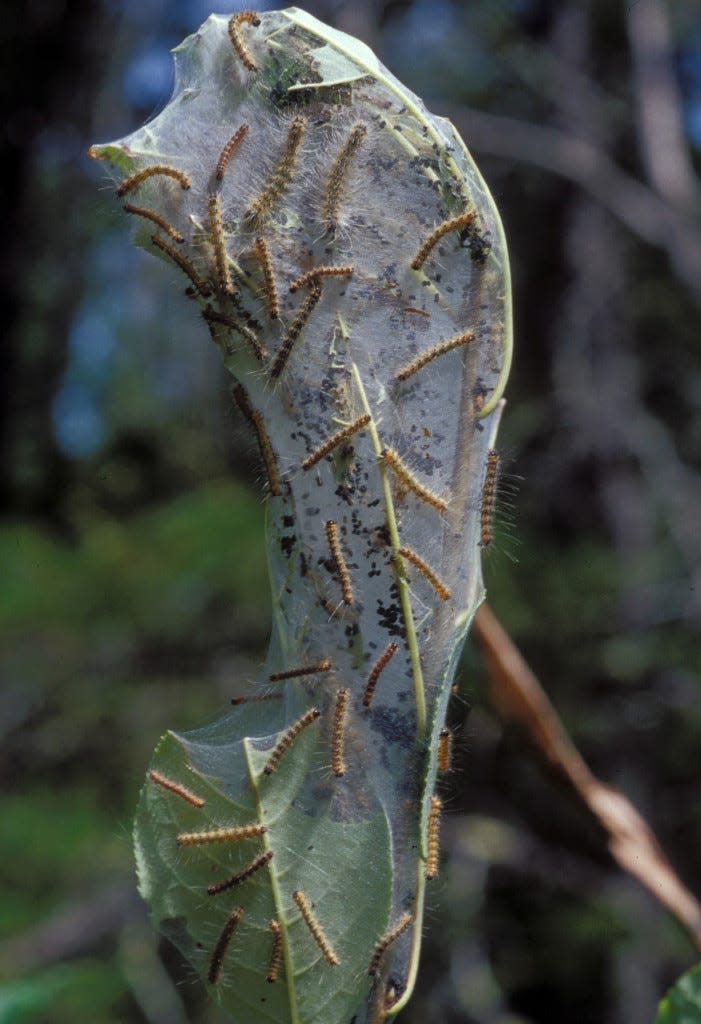Here's how to handle those late-summer webworms on your trees
The unsightly webbing you may have noticed at the branch ends of many landscape trees recently is constructed by the fall webworm.
This native pest is often discovered in late summer as they make their nests of web-enclosed leaves and small branches. The fall webworm occurs throughout the United States and is know to feed on more than 85 species of trees.
Pecan, walnut, American elm, hickory, fruit trees and some maples are preferred hosts. Ornamentals such as birch, lilac, crabapple, cherry, and redbud are also common hosts.
Fall webworms begin their life as small, yellow or light green eggs deposited on the underside of leaves in hair-covered masses by the female moth. The eggs are usually laid in a single or double layer of several hundred from May to July. Eggs hatch within two weeks and the larvae immediately begin feeding. Young larvae are pale yellow with two rows of black marks along their bodies.

They feed in groups by webbing over and skeletonizing individual leaves. These webs are started near the tips of branches and gradually are extended down the branch towards the trunk. As they feed, the larvae grow to 1 to 1.5 inches long and are covered with whitish hairs that originate from black and orange warts.
They will also make more webbing, sometimes surrounding two to three feet of a branch to consume the foliage. The caterpillars make distinct jerking movements in unison if the nest is disturbed. They will feed for four to eight weeks; however there may be multiple webs on the tree and more than one generation per year.
Heavy feeding will defoliate a tree but rarely kill it. Injury is mostly aesthetic, because of the unsightliness of the webs, which sometimes remain through winter. Because feeding occurs late in the season and nests are generally concentrated to limited areas, little real damage occurs.
When the larvae mature, they leave the web and spin thin cocoons in which to pupate. This stage occurs just beneath the soil surface, under loose bark or leaf litter. The larva will remain in the cocoon through winter and emerge as a snowy white moth (about 1 inch between wingtips) from late May into July.
Some moths may have dark spots on the wings. The females will lay their egg clusters on the leaves and the cycle repeats.
There are many methods for controlling this pest either with or without chemicals. The following have proven effective when used alone or combined with other methods.
Manual control: Where webs are accessible, prune or remove the nests by hand. This works best when done early in the season. Once removed the nests can be crushed or burned. Do not burn the nest while they are in the trees as this may cause additional damage to the tree.
Biological control: Natural predators like yellow jackets, paper nest wasps, birds, and predatory stink bugs feed on the Fall Webworm and help to manage this insect. The bacterial insecticide, Bacillus thuringiensis (Bt), is also effective against fall webworms if applied when larvae are small. Spray to cover the foliage next to the nests as Bt must be ingested to be effective.
Chemical control: Apply insecticides such as Sevin, Bug-B-Gone, or Diazinon directly to the web and nearby foliage. As larvae walk on the nest surface or feed on new foliage, they will contact the insecticide. It is not necessary to force insecticide into the nests. If nests are difficult to reach, use a translocated systemic insecticide, such as Orthene Systemic Insect Killer, applied to the soil for root uptake.
P. Andrew Rideout is the University of Kentucky Extension Agent for Horticulture at the Henderson County Extension Office. You can reach him by email at pandrewrideout@uky.edu.
This article originally appeared on Henderson Gleaner: Here's how to handle those late-summer webworms on your trees

